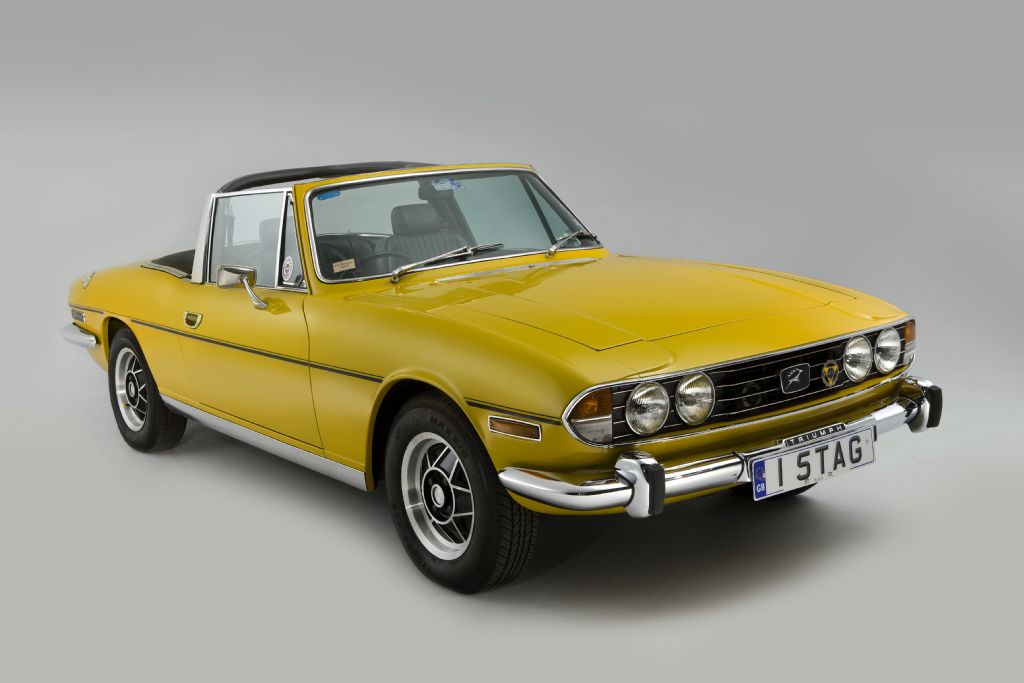Home > Classic Car Data > Triumph Stag
Triumph Stag
Intelligence Data:
About the Triumph Stag
The Triumph Stag is a 2+2 sports tourer sold between 1970 and 1978 by the British Triumph Motor Company, styled by Italian designer Giovanni Michelotti.
Envisioned as a luxury sports car, the Triumph Stag was designed to compete directly with the Mercedes-Benz SL class models. All Stags were four-seater convertible coupés, but for structural rigidity – and to meet new American rollover standards of the time – the Stag required a B-pillar "roll bar" hoop connected to the windscreen frame by a T-bar. A removable hardtop was a popular factory option for the early Stags, and was later supplied as a standard fitment.
The initial Stag design was based around the saloon's 2.5-litre six cylinder engine, but Harry Webster intended the Stag, large saloons and estate cars to use a new Triumph-designed overhead cam (OHC) 2.5-litre fuel injected (PI) V8. Under the direction of Harry Webster's successor, Spen King in 1968, the new Triumph OHC 2.5 PI V8 was enlarged to 2997 cc (3.0 litres) to increase torque. To meet emission standards in the USA, a key target market, the troublesome mechanical fuel injection was dropped in favour of dual Zenith-Stromberg 175 CDSE carburettors.
Perhaps thanks to the Stag engine's reputation for unreliability, only 25,877 cars were produced between 1970 and 1977. Of this number, 6,780 were export models, of which 2,871 went to the United States. Several variants were produced, indicated by the factory as initial production, followed by 1st, 2nd, 3rd and 4th "sanction" changes, as noted only in changes of the production numbering sequences. These have become unofficially designated as "Early" Mk I 1970, Mk I (1971–72/3), Mk II (1973) and "Late" Mk II or Mk III (1974–77).
The most notable differentiating features between Mark I and Mark II Stags are the sills and tail panel, which are body-colour on the earlier car and low-gloss black on the later. The addition of twin coachlines is an indication of a Mk II variant. Inside, early cars had a slightly different warning light cluster and the instrument dial needles point down rather than up. They also had two courtesy lights at the top of the B posts rather than the later configuration of one in the T-Bar, and also had a map-reading light fitted to the door of the glove box, whereas later cars had a light inside. Very early production cars had a three-quarter window in the soft top, which was quickly deleted as it tended to become trapped and then to split when stowed. Mark III cars returned to having body-colour sills and tail panel, but some acquired a stainless steel sill cover. This item was originally fitted to US Stags and the surplus stock of these that had accumulated when the Stag was withdrawn from the US was used up on cars for other markets. Stags thus fitted are usually considered Mark III Stags, though it is not clear that all had them, and many early Stags have since had them retrofitted. Mechanically, late Stags fitted with the slightly longer BW65 automatic transmission had a correspondingly shorter propshaft to compensate. A high-pressure cooling system was introduced and fitted to later Mark Two Stags.
Steel shell
Engine : All alloy sohc per bank. Twin Zenith Stromberg carbs
Transmission : 4-speed manual, with overdrive or automatic, rear wheel drive.
Suspension : Independent, coil springs.
Brakes : Discs at the front, drums at the rear. Servo assist
Steering : Power assisted rack and pinion
Vital Statistics
| Years: | 1970 to 1977 |
| Produced: | 25877 vehicles |
| Capacity: | 2997 cc |
| Engine: | V8 OHC |
| Power: | 145 bhp at 5,500 rpm |
| Top Speed: | 118 mph |
| 0-60mph: | 9.5 Secs |
| MPG: | 20 |
Source: Wikipedia
Source: Stag Owners Club
Search Database
Classified Alerts
We can help you find the classic vehicle you desire.
Advertise Here
You can advertise your business here. Call us on
01892 457670

